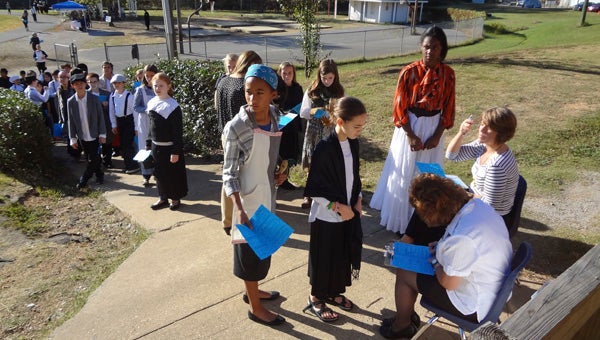Lesson on immigration: CHMS sixth graders participate in Ellis Island simulation
Published 3:32 pm Wednesday, October 14, 2015

Sixth grade students at Chelsea Middle School wait in a line at an immigration station, one of several stations they visited during an Ellis Island simulation activity Oct. 14. (Reporter Photo/Emily Sparacino)
By EMILY SPARACINO / Staff Writer
CHELSEA – The Chelsea Middle School outdoor track took on a new identity–as did hundreds of sixth graders–during an immigration-themed simulation Oct. 14.
The track became Ellis Island, a small island in New York Harbor where millions of immigrants entered America in the late 19th and early 20th centuries. More than 345 sixth graders became the immigrants on their journey to a new life in America.
“This follows sixth grade social studies curriculum,” CHMS social studies teacher Michelle Caiola said of the simulation, adding it will carry as much weight as a test grade for students. “They’re very excited.”
Caiola spearheads the program, which has been held at CHMS for at least five years, and said it is relevant to students since current immigration numbers are beginning to mirror those from 1880-1920.
“Only 2 percent of anybody who went through Ellis Island was turned away,” Caiola said. “Right now, we’re back up to really high immigration numbers again in America. We were at 25 percent growth in immigration.”
Students prepared for the simulation by choosing a new name and filling out an application for citizenship, complete with their country of origin, their occupation, whether they had criminal records, whether they had relatives in America and their religion.
“Most of the immigrants were from eastern or southern Europe,” Caiola said.
They also wrote letters to family members and friends they were “leaving behind” to seek new opportunities in America, CHMS social studies teacher Rita McMahan said.
“We’ve spent three weeks just prepping them on what is an immigrant,” McMahan said. “A lot of these kids didn’t know what an immigrant was. We spent a lot of time teaching reasons why you would leave where you were born. It’s just been a great learning experience for them, and they’re into this.”
During the Oct. 14 simulation, students walked to different stations as if they were being processed at Ellis Island.
Stations included background check, detention center, court, medical area, literacy, immigration and steerage.
Sixth grader Erin Prady, 11, said she was relieved when she finished the stations and passed her immigration check to enter America.
“You kind of get nervous for a second because you didn’t know what they were going to ask, but then you’re like it’s so easy,” Prady said.
Sean Brooks, 11, said the simulation gave him a glimpse of criteria immigrants had to meet to be granted citizenship.
“It kind of felt like we were actually in it, but a little more moderned out,” Brooks said. “It was a lot different, and I kind of liked having different moments.”
Eleven-year-old Lucas Pace assumed an identity as an immigrant from Hungary.
Pace admitted he was nervous when the simulation started about possibly being sent to the detention center or the medical area for an illness, and then being turned away at the immigration station.
“Coming into America can be really hard to understand,” Pace said. “I learned that I hope that I would be able to come to America. I was just really happy that I did pass through.”
Students’ parents helped set up and conduct the simulation.
Kelly Reid, whose daughter Grier was going through the simulation, volunteered at the steerage station.
“I wasn’t sure exactly what to expect, but the kids seem really excited,” Reid said.
Students will write journal entries about their experiences in the simulation, McMahan said.
“It’s a long day, but it’s worth it,” McMahan said. “We see such excitement on their faces. It’s a good way to teach, and it takes a break from the textbook.”









